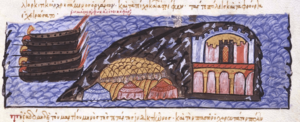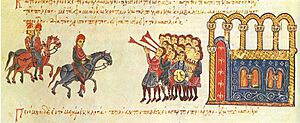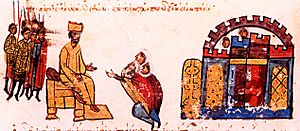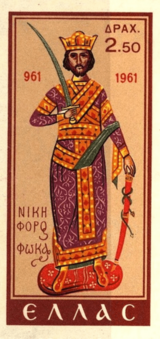Nikephoros II Phokas facts for kids
Quick facts for kids Nikephoros II Phokas |
|
|---|---|
| Emperor and Autocrat of the Romans | |
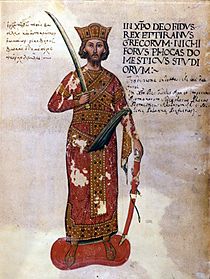
Nikephoros II Phokas on a 15th-century manuscript, Biblioteca Marciana, Venice
|
|
| Byzantine emperor | |
| Reign | 16 August 963 – 11 December 969 |
| Predecessor | Romanos II |
| Successor | John I |
| Born | c. 912 Cappadocia |
| Died | 11 December 969 (aged 57) Constantinople |
| Burial | Church of the Holy Apostles |
| Spouse | Theophano |
| Dynasty | Macedonian dynasty |
| Father | Bardas Phokas |
| Saint Nikephoros II Phokas |
|
|---|---|
| Emperor of Rome | |
| Venerated in | Eastern Orthodox Church |
| Feast | December 11 |
Nikephoros II Phokas (Νικηφόρος Φωκᾶς; c. 912 – 11 December 969) was a Byzantine emperor who ruled from 963 to 969. He was a brilliant military leader whose victories helped the Byzantine Empire become strong again in the 10th century. In the east, Nikephoros conquered Cilicia and took back the islands of Crete and Cyprus. His campaigns opened the way for Byzantine armies to reach places like Upper Mesopotamia and the Levant. These victories earned him the nickname "pale death of the Saracens," meaning he was a terrifying enemy to the Muslim armies.
Contents
Early Life and Military Career
Nikephoros Phokas was born around 912. He came from the Phokas family, known for producing many great generals. His father, Bardas Phokas, and brother, Leo Phokas, were also important commanders. His mother's family, the Maleinoi, was also powerful in Cappadocia. Early in his life, Nikephoros married Stephano, but she died before he became famous. After her death, he promised to live a life of chastity.
Leading the Eastern Army
Nikephoros joined the army when he was young. In 945, he became the military governor of the Anatolic Theme. In 954 or 955, he was promoted to commander of the eastern Byzantine army, replacing his father. His father had faced several defeats by the Hamdanids and Abbasids. Under Nikephoros, the Hamdanids in Aleppo began to decline. In June 957, Nikephoros captured and destroyed the city of Adata. The Byzantines continued to gain ground against the Arabs.
Taking Back Crete
When Emperor Romanos II came to power in 959, Nikephoros was put in charge of the eastern army, and his brother Leo led the western army. In 960, a huge fleet was gathered with 308 ships and 50,000 soldiers. Nikephoros was chosen to lead this mission against the Muslim Emirate of Crete. He sailed to the island and defeated a small Arab force.
He then began a nine-month siege of the fortress town of Chandax. His troops faced difficulties during the winter due to lack of supplies. After a failed attack, Nikephoros finally entered Chandax on March 6, 961. He quickly took control of the entire island from the Muslims. When he returned to Constantinople, he was not given a full triumph, but he did receive a special celebration in the Hippodrome.
More Eastern Victories
After conquering Crete, Nikephoros returned to the east. He led a large, well-equipped army into Cilicia. In February 962, he captured Anazarbos. The important city of Tarsus stopped recognizing the Hamdanid ruler of Aleppo. Nikephoros continued to attack the Cilician countryside. He defeated the governor of Tarsus, ibn al-Zayyat, in battle.
When the new fighting season began, the Hamdanid ruler, Sayf al-Dawla, raided the Byzantine Empire. This left Aleppo poorly defended. Nikephoros quickly took Syrian Hierapolis. In December, armies led by Nikephoros and John I Tzimiskes marched towards Aleppo. They easily defeated the opposing forces. Nikephoros and Tzimiskes entered Aleppo on December 24. Losing Aleppo was a big blow for the Hamdanids. It was likely during these campaigns that Nikephoros earned his nickname, "The Pale Death of the Saracens."
Becoming Emperor
On March 15, 963, Emperor Romanos II died suddenly at age twenty-six. Some people, including historians, believed his wife, Empress Theophano, might have poisoned him. Theophano was known as a smart and ambitious woman. Romanos had already crowned his two young sons, Basil II and Constantine VIII, as co-emperors. Since Basil was five and Constantine was three, Theophano became the regent, meaning she would rule until they were old enough.
However, Theophano was not allowed to rule alone. Joseph Bringas, a powerful palace official, wanted to keep control. He also tried to reduce Nikephoros Phokas's power. Nikephoros was a popular general and had strong ties to the wealthy families. Bringas feared that Nikephoros would try to become emperor with the army's support.
Bringas was right. On July 2 in Caesarea, Nikephoros's armies and officers declared him emperor. Nikephoros sent a fleet to control the Bosphorus Strait and prevent his enemies from attacking. He also made Tzimiskes the new commander of the eastern army. Nikephoros then sent a letter to Constantinople, asking to be accepted as co-emperor.
In response, Bringas locked down the city. Nikephoros's father, Bardas Phokas, had to seek safety in the Hagia Sophia. His brother, Leo Phokas, escaped the city in disguise. Bringas found some support, but he was not good at convincing people. He couldn't get the support of important figures like the Patriarch Polyeuctus. The people of Constantinople soon turned against Bringas. They rioted and forced him to flee. On August 16, Nikephoros was officially declared emperor and married Empress Theophano.
Nikephoros's Reign
Wars in the West
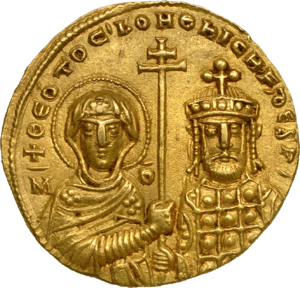
Nikephoros II did not have as much success in his western wars. Relations with the Bulgarians became worse. He likely paid the Kievan Rus' to raid the Bulgarians because they didn't stop Magyar raids. This led to a long period of bad relations between the Byzantines and Bulgarians.
Nikephoros's first military problems were in Sicily. In 962, the son of the Fatimid governor of Sicily captured the Byzantine city of Taormina. The last major Byzantine stronghold in Sicily, Rometta, asked Nikephoros for help. Nikephoros stopped paying tribute to the Fatimid caliphs. He sent a huge fleet with about 40,000 men to the island. However, the Byzantine forces were quickly defeated in Rometta and at the Battle of the Straits. Rometta soon fell to the Muslims, completing the Islamic conquest of Sicily.
In 967, the Byzantines and Fatimids made a quick peace treaty in Sicily. Both empires had bigger problems to deal with. The Fatimids were planning to invade Egypt. Tensions were also rising in mainland Italy between the Byzantines and the German emperor Otto I. Both empires claimed to be the successors of the Roman Empire, which caused conflict. Otto invaded Byzantine Apulia in 968 but failed to take Bari. He tried again the next year but couldn't capture any major cities. The two empires continued to fight, but neither side gained much.
Eastern Conquests
From 964 to 965, Nikephoros led an army of 40,000 men. They conquered Cilicia and raided areas in Upper Mesopotamia and Syria. At the same time, Niketas Chalkoutzes took back Cyprus. In the spring of 964, Nikephoros went east. He captured Anazarbos and Adana before returning. Later that year, he tried to take Mopsuestia but failed.
In the summer of 965, the full conquest of Cilicia began. Nikephoros and Tzimiskes captured Mopsuestia on July 13. Leo Phokas surrounded Tarsus, and Nikephoros and Tzimiskes soon joined him. Nikephoros won a major battle against the Tarsiots with his "ironclad horsemen," which were the Byzantine cataphracts (heavily armored cavalry). Within two weeks, Tarsus surrendered on August 16. Nikephoros allowed the people to leave the city unharmed but took its riches. With these two strongholds captured, Cilicia was now under Byzantine control.
In June 966, there was an exchange of prisoners between Sayf al-Dawla and the Byzantines at Samosata. In October 966, Nikephoros led another expedition. He raided Amida, Dara, and Nisibis. Then he marched towards Hierapolis, where he took a holy relic (an image of Jesus) to be placed in a church in Constantinople. He continued to raid many cities and fortresses, reaching Tripoli. His goal was to cut off Antioch from its allies.
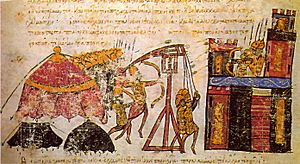
Antioch had been blockaded twice without success. So, the emperor decided to try to take it by starving the city, to avoid damaging it. He left 1500 men in the fort of Baghras. The commander of the fort, Michael Bourtzes, disobeyed the emperor's orders. He launched a surprise attack and took Antioch with the help of other troops. Bourtzes was punished for his disobedience, and he later joined the plot to kill Nikephoros.
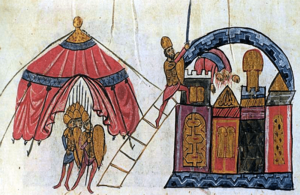
Ruling the Empire
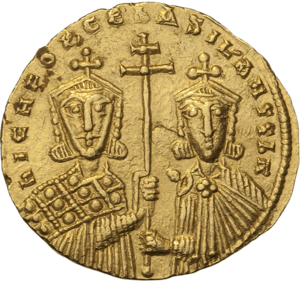
Nikephoros was popular because of his military victories. However, he spent a lot of money on his army. This meant he had to be very strict with the empire's finances. He reduced spending at court and limited the special rights of the clergy (church officials). Even though he lived a simple life himself, he did not allow new monasteries to be built. He also raised taxes and changed the value of the Byzantine currency, making it worth less. These actions made him unpopular with the people and led to riots.
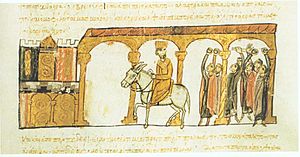
Nikephoros also had disagreements with the church. He wanted the church to declare soldiers who died fighting Muslims as martyrs. This was a very controversial idea in the Christian church.
In 967, he caused a stir in Constantinople by holding military displays in the Hippodrome. The crowd panicked and tried to leave the stadium, causing many deaths.
Nikephoros wrote books about military tactics. His most famous work is the Praecepta Militaria, which has important information about warfare in his time. He was also a very religious man. He helped his friend, the monk Athanasios, establish the Great Lavra monastery on Mount Athos.
Death of an Emperor
The plan to kill Nikephoros began when he removed Michael Bourtzes from his position for disobeying orders at Antioch. Bourtzes was angry and found an ally in John I Tzimiskes. Nikephoros had exiled Tzimiskes earlier for suspected disloyalty. However, Nikephoros's wife, Theophano, convinced him to bring Tzimiskes back.
According to historical accounts, Nikephoros and Theophano had an unhappy marriage. Nikephoros lived a very strict, simple life. Theophano and Tzimiskes plotted to overthrow the emperor. On the night of December 11, 969, Theophano left Nikephoros's bedroom door unlocked. Tzimiskes and his group entered and killed Nikephoros in his apartment. After his death, Nikephoros's nephew, Bardas Phokas, tried to start a rebellion, but it was quickly stopped as Tzimiskes became the new emperor.
Legacy of Nikephoros II
Nikephoros's policies caused tension between the East and West. Bishop Liutprand of Cremona described him and his court in an unflattering way in his book Relatio de legatione Constantinopolitana. Liutprand's description was negative because he was treated poorly during a diplomatic mission to Constantinople. Nikephoros was a man of war, not diplomacy. To make matters worse, Pope John XIII sent a letter to Nikephoros calling Otto I "Emperor of Rome" and calling Nikephoros only "Emperor of the Greeks." Liutprand failed in his goal to arrange a marriage between a Byzantine princess and Otto's son.
Bishop Liutprand described Nikephoros as: "...a monstrosity of a man, a pygmy, fat-headed and like a mole as to the smallness of his eyes; disgusting with his short, broad, thick, and half hoary beard; disgraced by a neck an inch long; very bristly through the length and thickness of his hair; in color an Ethiopian; one whom it would not be pleasant to meet in the middle of the night; with extensive belly, lean of loin, very long of hip considering his short stature, small of shank, proportionate as to his heels and feet; clad in a garment costly but too old, and foul-smelling and faded through age; shod with Sicyonian shoes; bold of tongue, a fox by nature, in perjury, and lying a Ulysses."
However, another writer, Leo the Deacon, said the emperor's hair was black with "tight curls" and "unusually long."
Historian John Julius Norwich wrote about Nikephoros's death and burial: "It was an honourable place; but Nikephoros Phocas, the White Death of the Saracens, hero of Syria and Crete, saintly and hideous, magnificent and insufferable, had deserved a better end."
Family and Future Rebellions
In the late 10th century, the Phokas family tried many times to regain the throne. Nikephoros's nephew, Bardas Phokas the Younger, almost succeeded in rebelling against Emperor Basil II. His death, possibly from a heart attack, ended the rebellion and the political power of the Phokas family. However, Bardas the Younger's own son, Nikephoros Phokas Barytrachelos, launched another failed revolt in 1022.
Military Writings
Nikephoros wrote a military handbook called the Praecepta Militaria.
Modern Honors
On November 19, 2004, the Hellenic Navy named one of its frigates, the Nikiforos Fokas F-466, in his honor. Also, in the Rethymno regional unit in Crete, a municipality (a type of local government area) is named after him, as are many streets throughout Greece.
See also
 In Spanish: Nicéforo II para niños
In Spanish: Nicéforo II para niños
- Phokas (Byzantine family)
- 10th century in Lebanon § Revolt of Tripoli


